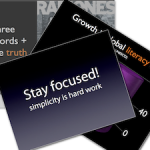Miles Davis was unhappy.
![]()
“The music has gotten thick,” Davis said. “Guys give me tunes and they’re full of chords.”
It was a problem he was ready to solve.
He assembled a group of legendary musicians and over two sessions in March and April of 1959, they performed and recorded Kind of Blue.
The sessions featured almost no rehearsals. There was no sheet music.
Band members were given rough instructions on how each song was meant to be played, instead leaning heavily on melody and improvisation.
The results were stunning.
Kind of Blue remains one of the best selling jazz records and is pointed to by many music critics as one of the most influential recordings of all time.
Simplicity is commonly pointed to among the achievements of this important record.
It’s an accurate choice of words here. But I’m reminded of how often simplicity gets misused to describe the ambitions of a wide range of creative work.
Maybe you’ve heard some of these at a boardroom table before:
“Let’s build with simplicity in mind…”
“We need to simplify the steps required to use this product…”
“Don’t complicate: keep it simple…”
Simplicity is not a process.
It’s tempting to think of simplicity as the act of paring until you’re down to the bare essence of an idea, product or message.
In fact, that’s just good editing.
As Jony Ive, head of design at Apple reminds: “simplicity is not the absence of clutter.”
Sure, as far as writing is concerned, tighter ideas and economy of language are important. But it’s a mistake to assume there’s a process you can adopt to yield simplicity. It’s much more elemental than that.
Turning back to Kind of Blue, it succeeds in its “exquisite simplicity” (as Bill Evans calls it in the album’s liner notes), because Miles Davis started with a clear definition of a problem he wanted to solve.
More than just to music, this applies to all creative work.
And that leads me to my second point.
Simplicity is an outcome of deep understanding.
Early in my career, I padded my writing with lots of literary ornaments: dense paragraphs and plenty of five-dollar words.
Why? Because I lived in constant fear that I’d be found out as a fraud and that I’d have to return my writer’s licence to the Bureau of People Smarter Than Me.
I was half right. Without first having a deep understanding of the problem I’d been tasked with solving, I was regularly putting myself at risk of seeming to dumb things down, rather than finding the heart of an idea.
I still struggle with this, but I do so now at least with the conviction that I’ll study the heck out of my customer’s business problems first before I even attempt to solve them with strategy and prose.
Simplicity is preceded by mastery.
One reviewer in summing up Kind of Blue says how it “sounded different from the jazz that came before it. But what made it so great? The answer here is simple: the musicians.”
Too often, simplicity is thought of as the act of making things look easy. Or that its spareness comes from a kind of idleness.
Simplicity comes only after you’ve begun to exercise mastery of your skills.
Even then, it comes slowly.
Miles Davis explained it best:“You have to play a long time to be able to play like yourself.”
As I see it, writing of all kinds can only start to achieve simplicity—satisfying simplicity—after you’ve dug deeply into your thoughts and have exhausted yourself by writing long form.
I don’t pretend to suggest I’m there yet.
But like you, I get closer, word by word.
